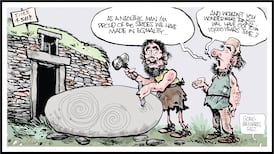What is the cost of the bust to our annual income tax bills ? About €2,500 on average, if you want a quick answer – and a good bit more for most middle- to higher-income employees. That is the rough increase in the size of the average income tax bill since the crash. If we are wondering why consumer spending has been slow to take off and why confidence is volatile, maybe the answer is here.
During the week Goodbody Stockbrokers’ economist Dermot O’Leary said income tax and universal social charge (USC) receipts were now about €5 billion higher than at their lowest point in 2010. This has been the key factor in moving overall tax revenues back to pre-crash levels, with higher corporation tax also helping. If you do a quick calculation, this comes down to about €2,500 each year for everyone in work; in fact, the increase is a bit more if you take into account the fact that employment levels have still not returned to their pre-crash peak.
For most of those who are in the income tax net, the actual increase will be greater. That is because more than a third of those in work are on incomes low enough to ensure they pay no income tax. If you adjust for this, the average is closer to €3,500 for those who fall within the net.
This puts the paltry water charge in the shade. With households also paying the residential property tax, disposable incomes have been hit significantly. And, of course, the impact varies enormously from one house to the next. But the overall sums are clear: we have all had our pockets raided.
No wonder, then, that households have taken time to find their feet after the economic bust, with the first real signs emerging late last year and into this year that consumer spending was finally starting to rise
The signs were that households were starting to get used to what you might call a “new normal”. They had some money to spend, even if it wasn’t as much, for most, as before the bust. They were also confident enough that growth was going to continue and that there was nothing on the horizon likely to hit their income levels.
And so this vital cog of economic recovery – consumer spending growth – was finally starting to turn.
There is a risk that this confidence will wane, at least a bit, in the wake of Brexit. Already, during the spring, the KBC/ESRI consumer confidence index had shown that sentiment was starting to soften. The reasons for this were not clear, though the researchers involved in putting the survey together speculated that the limited gains people were feeling in their pocket from the economic recovery were one factor. Job losses had also just been announced at Intel. There was a feeling that the economy might be coming off the boil.
Cause for caution
Recently, cause for caution has grown. Since the Brexit vote, there have been signs of slowing in growth in manufacturing and services, while consumer confidence has slipped, though not too rapidly yet. There was a fall-off in VAT and excise duty in the latest tax figures for July.
The economic signals from the UK are poor and a leading recruiter there said yesterday that the jobs market was in “free fall”. This is bound to have some impact here. Most forecasters have cut their predictions for growth here, particularly for next year, though most still expect reasonable growth of 3 per cent plus.
The Government will hope that consumers will take a pragmatic approach and carry on spending. This is vital if growth targets are to be hit. Minister for Finance Michael Noonan will also know that he has some leeway in his budget sums and even if the 2016 growth outlook has to be trimmed, he may still be able to afford the planned €1 billion in additional spending and tax measures. The recent crazy GDP revision may also help by putting a better gloss on the budget deficit figures.
But there are political dangers. So far, the Government has had the wind behind it, with the real rate of growth – let’s ignore the 26 per cent here – exceeding expectations and budget figures coming in consistently ahead of target.
Mixed message
Now it will have to sell a more mixed message. Growth is likely to slow and Brexit will bring challenges. The economy remains in reasonable shape and we may be able to weather Brexit, whatever it may bring. But the days of all the key figures coming in ahead of target month after month are probably over – and there are consequences. Up to now, the Government has tried to sell the line that the measures taken during the economic “emergency” would be gradually unwound. Public pay would rise, and the USC would be abolished. Slower growth will hammer home the unreality of this.
The exchequer finances were bust in 2010. Returning to the same tax and spending levels is not a great plan, even if economic growth may close some of the hole. And this wasn’t all down to rescuing the banks. We needed higher tax and lower spending to close a gaping hole between what we raised as a nation and what we spent.
We were, to borrow the famous Charlie Haughey phrase, living beyond our means. You can argue about the means used to fill the hole, but one way or another it had to be done. We had better get used to paying out our extra few thousand every year in income tax and charges. The “squeezed middle” is going to remain squeezed.










